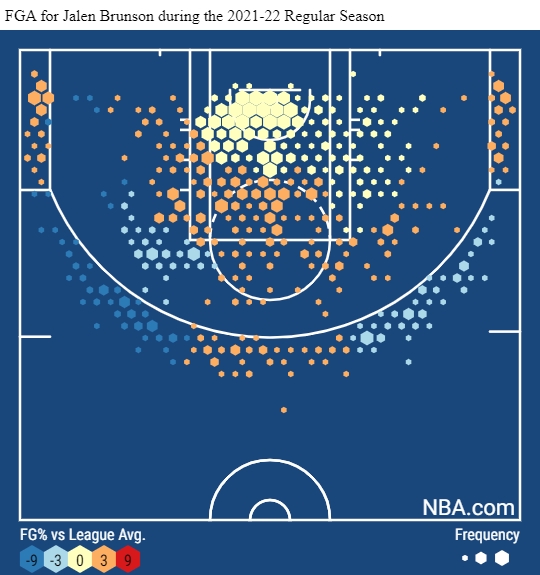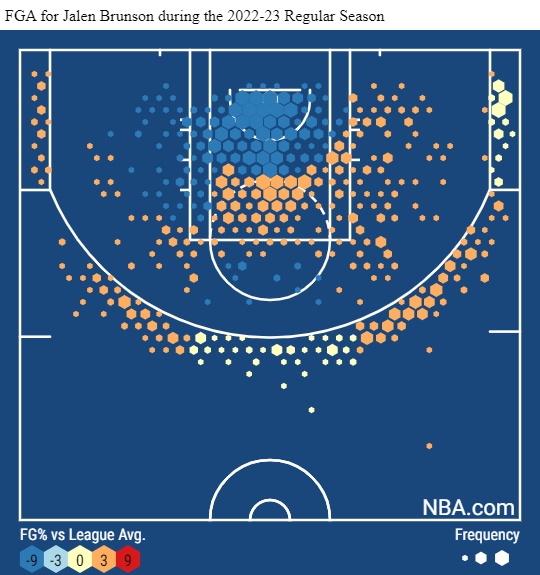In the first round of the 2021 NBA playoffs, the Dallas Mavericks battled the Los Angeles Clippers in a Game 7 on the road where Luka Doncic registered 46 points and 14 assists in 45 minutes of work. Dallas desperately needed an additional ball handler to lighten Doncic’s workload, but Jalen Brunson was unable to provide it. The former Villanova star scored just two points in 10 minutes and 26 seconds of work. Doncic’s brilliance was for naught, and the Maverick fell to the Clippers.
Brunson would enter the offseason extension eligible. Dallas did not offer an extension to Brunson prior to the 2022 season and he started the season in a bench role under new head coach Jason Kidd. Of course, you know what happened next: Brunson was a revelation, outplayed whatever contract the Mavs wanted him to sign, and eventually joined the New York Knicks on a 4-year deal worth $104 million.
Brunson has been, however you slice it, one of the best guards in basketball this year. And a closer look at his 2021-22 season in Dallas reveals that we probably should have seen it coming.
For as long as he’s been a basketball player, the methodical Brunson has prioritized efficiency through thoughtful shot making decisions within the arc. The questions around Brunson did not hinge on the quality of his play, but rather if his production could scale up enough to justify his price tag without sacrificing his efficiency. Last season, Brunson scored 16.3 points per game on 58.3 percent true shooting playing next to one of the best passers in basketball. This year, without Doncic as the straw that stirs the drink, he’s at 24 points per game on 59.7 percent true shooting.
The considerable bump in his scoring with a slight uptick in efficiency makes Brunson a candidate for the NBA’s Most Improved Player award, and makes New York a difficult team in the Eastern Conference playoffs. The huge jump in production could be attributed to Brunson no longer sharing ball handling responsibilities with the league’s most ball dominant shot creator, or Tom Thibodeau’s isolation-heavy offense that allows Brunson to poke and prod the defense with his hefty bag of moves, or the bright lights of New York inspiring Brunson to reach new heights in his career. Well, to get the answer, let’s take a look at how Brunson is now using the three-point line.
Last season, Brunson’s scoring production happened predominantly inside the arc. He was one of the league’s best interior scorers, finishing seventh in total field goals made in the paint’s non-restricted area despite being a 6’2 guard with — we’re being generous here — less-than-stellar hops. Inside the arc, Brunson bore all the markers of a star guard with his ability to consistently create open looks for himself and finish at a high rate; he was one of only 16 players who scored more than 16 points per game and shot over 50 percent from the field.
However, Brunson’s counting stats never jumped off the page because he never shot in volume, especially from behind the arc. He would routinely pass up open looks from three to prod the defense for a better shot, and while his intentions were good, the habit led to many stalled out possessions and hurt Brunson’s scoring numbers. The efficiency within the arc built a metronomic consistency into Brunson’s game, but without any large scoring outbursts, that reliability fed the perception that Brunson was a complementary player alongside a star and not an offensive engine. In his final regular season in Dallas, Brunson scored over 30 points just once while shooting just 3.2 three-pointers per game.
Brunson increased his three-point attempts to 4.7 a night this season, but he also completely changed his approach to shots from downtown. Last season, Brunson was primarily reliant on others (i.e.: Doncic) setting him up, as he shot 2.2 catch-and-shoot threes per game and only one pull-up three per game. Those attempts also rarely occurred in volume in single game — he attempted six or more threes just eight times all season and topped out at four made threes in single game.
In New York, Brunson has taken a more cavalier approach to the three-point line by shooting 2.8 pull up threes a game with 1.9 attempts coming in catch-and-shoot situations. The new mindset bears out in Brunson’s game logs, where he has attempted six or more threes 21 times this season, including a recent game against Cleveland in which he attempted 12. Related: He scored a career-high 48 points in that game.
The 2022 playoffs proved to be a line of demarcation for Brunson’s career. With Doncic missing the first three games of the postseason, Brunson shifted into a more aggressive scoring mindset that unlocked a new level of production. In a recent interview with Bleacher Report’s Chris Haynes, Brunson credited Kidd with fast tracking his progression prior to the playoffs. Brunson, a player who had only scored 30 or more points three times in his career to that point, eclipsed that mark three times during Dallas’ run to the Western Conference Finals, including a 41-point outing in the playoff opener with his future employers sitting courtside.
Brunson’s playoff run functioned as a statistical springboard for his first season with the Knicks. For all the discourse around Doncic’s usage hampering Brunson’s rise to stardom, the new king of New York registered a 27.8 percent usage during last year’s playoffs, which is only a hair more than his 27.2 percent usage with the Knicks this season. Not only did Brunson’s shot volume increase during the playoffs, he also reallocated some of his pull up twos for off the dribble threes from above the break.
In New York, Brunson has managed to increase his amount of two-point attempts without sacrificing the efficiency that made him so valuable in his time with the Mavericks. Because he’s let loose from beyond the arc, teams have to fight hard over screens to defend him, which allows Brunson to get to his bread and butter in those in between spaces inside the arc. Brunson has seen an increase in his two point attempts from 9.6 a game last year to 12.8 per game this year on similar efficiency — he hit 54.5 percent of his twos last season and finds himself at 51.9 percent this season.
The 2022 playoffs were essentially a trial run for Brunson’s new shot profile. Comparing his shot charts between last year and this year, it’s fair to wonder why Brunson didn’t shoot with more volume from beyond the arc during his final year as a Maverick.

NBA.com

It’s clear that Brunson was on the verge of making a big leap and the Knicks are reaping the benefits now. He’s always had all the intangibles and inside game to make him a good NBA point guard. With his willingness to let it fly from three and his ability to remain efficient as he shoulders more of an offensive load, Brunson gives Julius Randle the sort of running mate that makes New York dangerous heading into the postseason.







